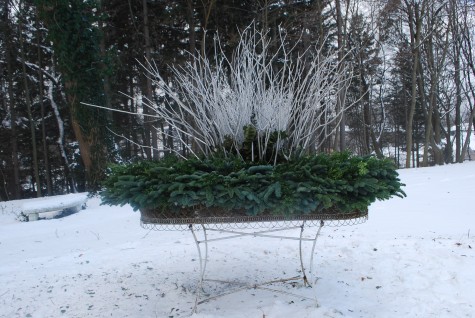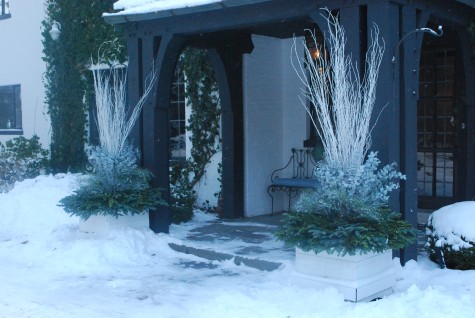 If you live in Michigan, white figures prominently in your winter landscape. On sunny days, this is a blinding white; on gloomy days, a blue/grey white. Chilly. White in the spring or summer landscape can be fresh and crisp; this is a white of a different sort. Our first snow fell fast and hard. The temperatures were actually above freezing; that snow stuck to everything it touched.
If you live in Michigan, white figures prominently in your winter landscape. On sunny days, this is a blinding white; on gloomy days, a blue/grey white. Chilly. White in the spring or summer landscape can be fresh and crisp; this is a white of a different sort. Our first snow fell fast and hard. The temperatures were actually above freezing; that snow stuck to everything it touched.

Driving was a challenge, but I am so glad I got to see these Himalayan white barked birch in a winter setting. I landscaped the common areas of this community a good many years ago. The birch planted in irregular drifts are paired with scotch pine, placed in a similar fashion. I like these two trees planted together. The stout long needled evergreens are a beautiful foil for the wispy birch. A green and white landscape. This day, the white clearly had the upper hand.
 The birch are planted in a large square picture frame around the entrance building-three trees wide. Planted on 12 foot centers, the lacy branches are beginning to meet overhead. My favorite part of the winter landscape is the ability to see the structure of woody plants. Though I am unhappy to see burning bush and the like pruned into artificial shapes, the winter look of this style of pruning is interesting. The overall shapes that many branches make can be be quite striking.
The birch are planted in a large square picture frame around the entrance building-three trees wide. Planted on 12 foot centers, the lacy branches are beginning to meet overhead. My favorite part of the winter landscape is the ability to see the structure of woody plants. Though I am unhappy to see burning bush and the like pruned into artificial shapes, the winter look of this style of pruning is interesting. The overall shapes that many branches make can be be quite striking.
 These birch were planted in a loose grove, and left unpruned. The landscape is quietly beautiful on a snowy day.
These birch were planted in a loose grove, and left unpruned. The landscape is quietly beautiful on a snowy day.
 I use lots of birch branches in winter containers. Their graceful and very twiggy appearance is in sharp contrast to the pole like stems of the willows. I am able to buy them from a farm in their natural state, and as lacquered natural branches. That shine is useful in some places. The branches are also available in a variety of colors-including white. For the holidays, they are available in platinum, silver and gold. This English antique oval wirework planter is 5 feet long, by about 30 inches wide-large. A long and dense centerpiece of white birch branches and green eucalyptus was good with the length of the planter, but this composition needed much more in the way of height and scale.
I use lots of birch branches in winter containers. Their graceful and very twiggy appearance is in sharp contrast to the pole like stems of the willows. I am able to buy them from a farm in their natural state, and as lacquered natural branches. That shine is useful in some places. The branches are also available in a variety of colors-including white. For the holidays, they are available in platinum, silver and gold. This English antique oval wirework planter is 5 feet long, by about 30 inches wide-large. A long and dense centerpiece of white birch branches and green eucalyptus was good with the length of the planter, but this composition needed much more in the way of height and scale.
 The long smooth branches-silver painted manzanita. These thick and sculptural branches were individually set around and over the inner centerpiece. Silver in a snowy setting such as this reads much like white. A planter of this size benefits from a mix of greens. Boxwood and noble fir contrast in color and texture. This mix helps keep the surface of this container lively looking.
The long smooth branches-silver painted manzanita. These thick and sculptural branches were individually set around and over the inner centerpiece. Silver in a snowy setting such as this reads much like white. A planter of this size benefits from a mix of greens. Boxwood and noble fir contrast in color and texture. This mix helps keep the surface of this container lively looking.
 Tall white birch branches and white frosted eucalyptus make a substantial statement in these square white wood boxes. A layer of faux snowy white pine picks add another layer to the centerpiece. A wide and low planter asks for some bulk around the middle.
Tall white birch branches and white frosted eucalyptus make a substantial statement in these square white wood boxes. A layer of faux snowy white pine picks add another layer to the centerpiece. A wide and low planter asks for some bulk around the middle.
 The faux branches have a windswept look that takes readily to a placement outdoors; they are convincing. Low and layered evergreens in the same mix finish the composition. Even on a very grey day like today these boxes have a festive winter look.
The faux branches have a windswept look that takes readily to a placement outdoors; they are convincing. Low and layered evergreens in the same mix finish the composition. Even on a very grey day like today these boxes have a festive winter look.

A small wire work planter gets a similar treatment, but in a wispy and scaled down way appropriate to the style and size of the planter. My client likes green and white, summer and winter.

White will be the predominant color of the landscape here for months to come; this white wirework planter needs the green as much as it needs a large scale white element. The white dining table overed in snow on this terrace- barely visible today.
I really enjoy your daily log. You state you green the container forms starting at the outside first working in. Please describe this form–is it flat, or cone shaped–I can’t tell from the one sitting on a container. Thanking you in advance for any explanation. We live in Brainerd, Mn and I really enjoy seeing and reading about the snowy landscapes you describe.
Sincerely, Karen Bolz
Dear Karen, we buy dry floral foam in sheets-and cut out the shape the size of the interior dimension of the container. We hot melt glue 2 thicknesses of foam, one on top of each other. The form itself is flat. The outside branches are long, and inserted into the form horizontally. Subsequent layers are shorter, and placed at increasingly vertical angles. Hope this helps! Thanks so much for reading, Deborah
Happy Holidays, Deborah!!
thank you for the daily gift of beauty, gardening advice, inspiration and just really pretty pictures that you give your readers.
So looking forward to another year of reading your lovely blog.
nanne